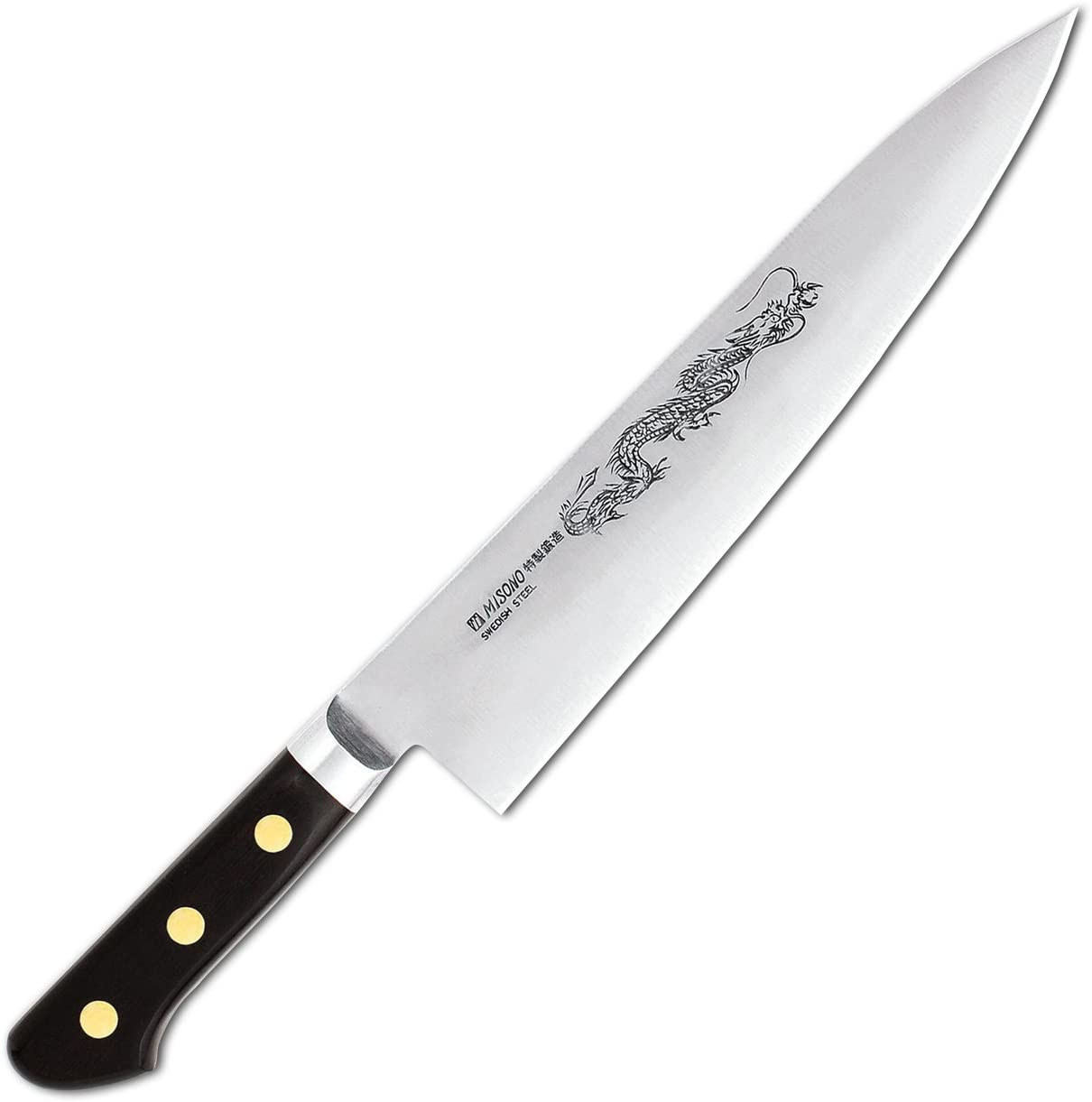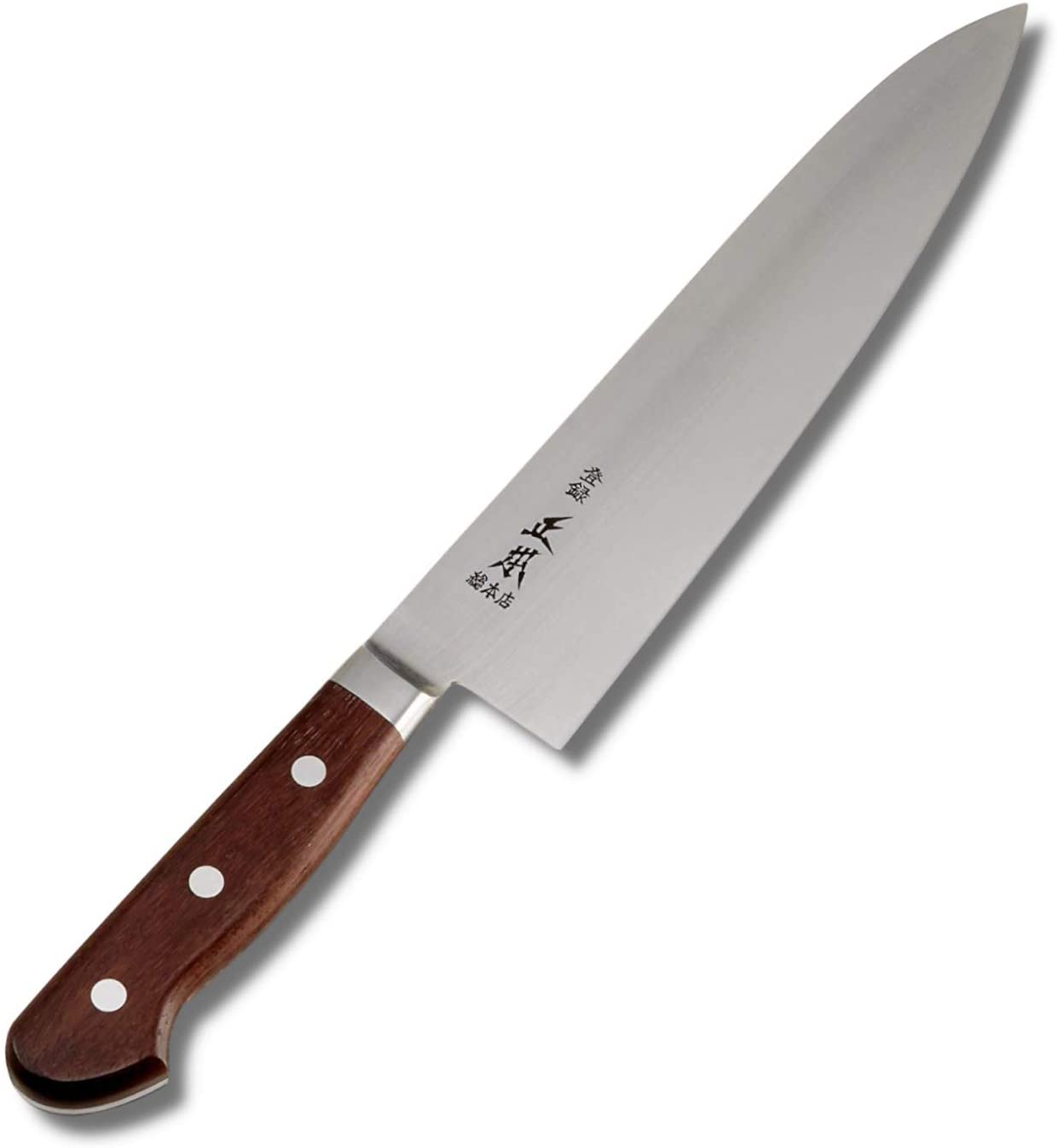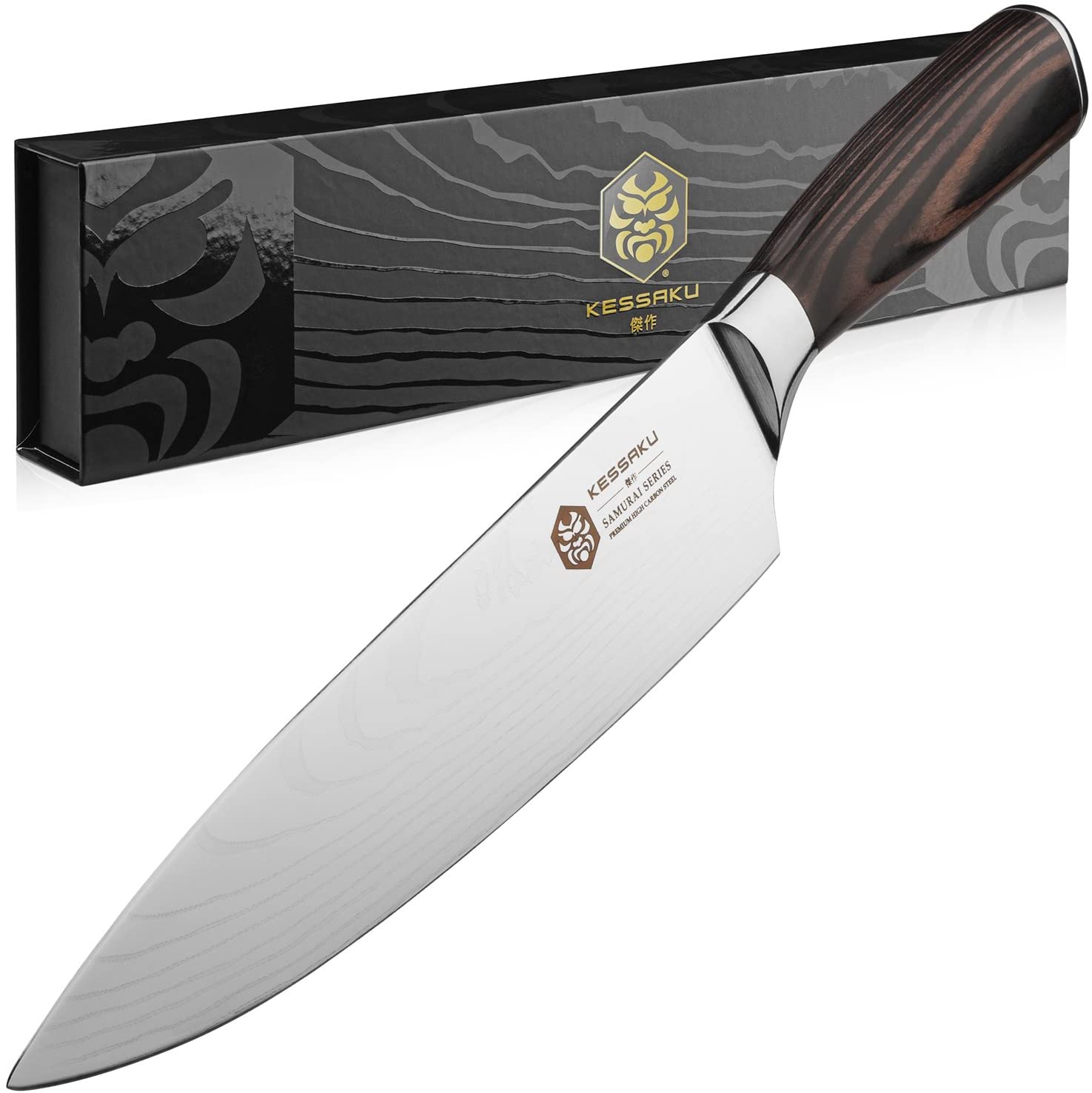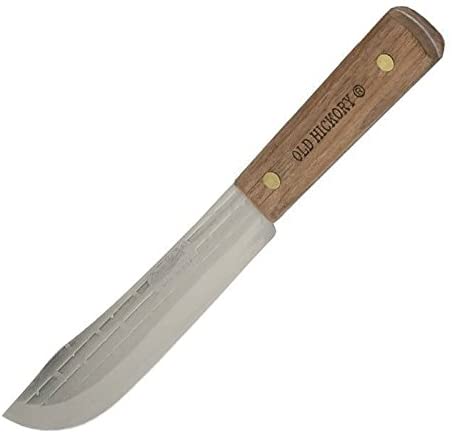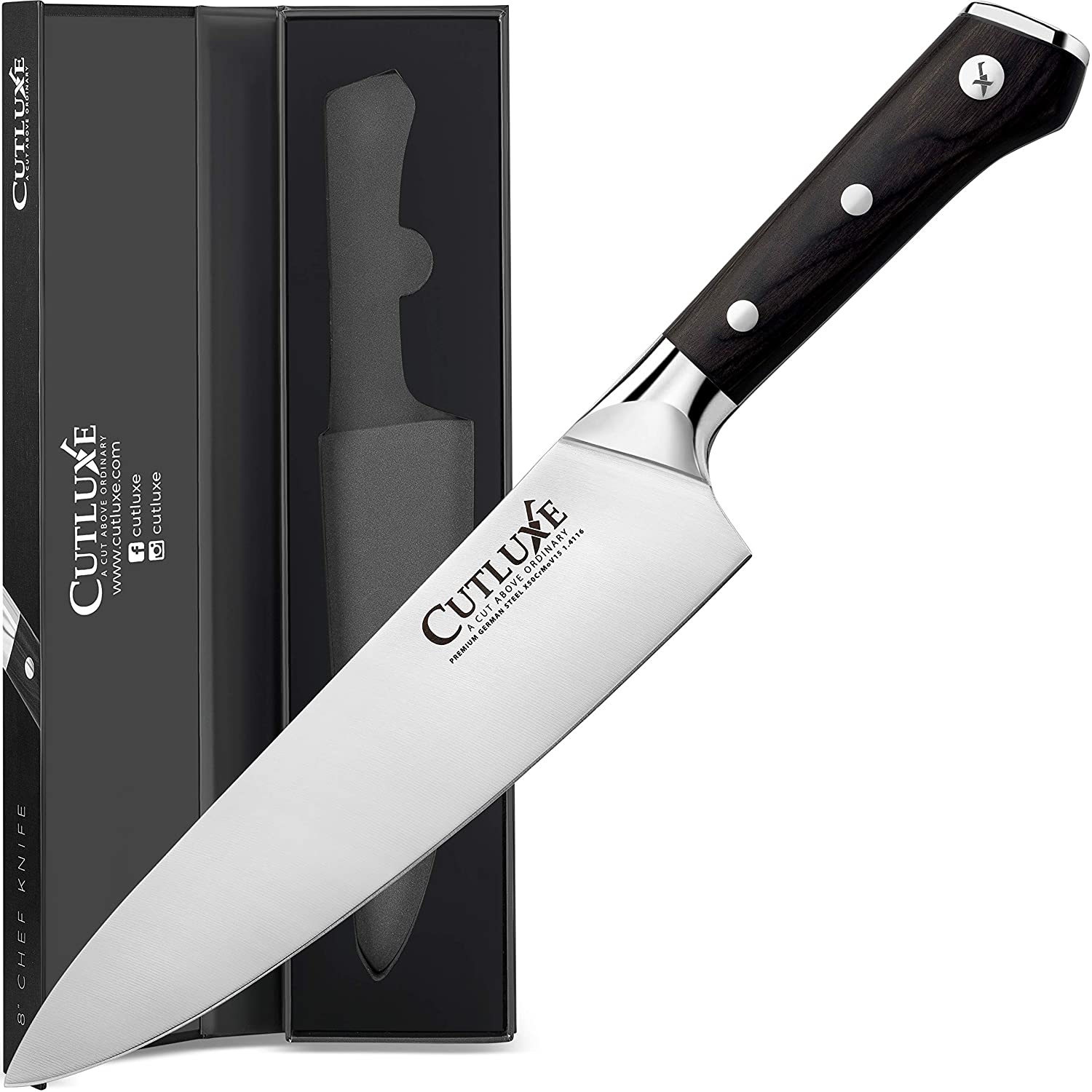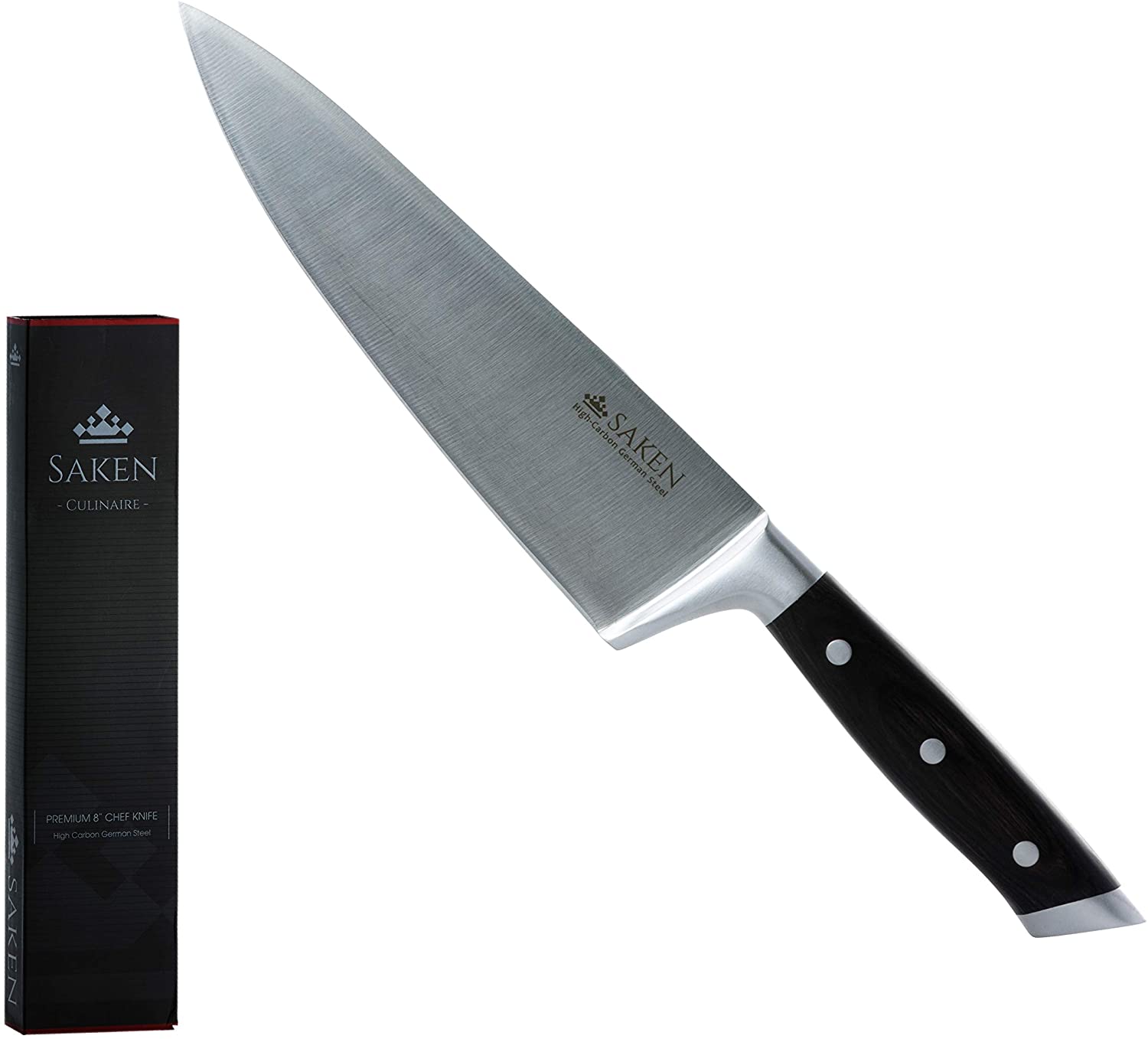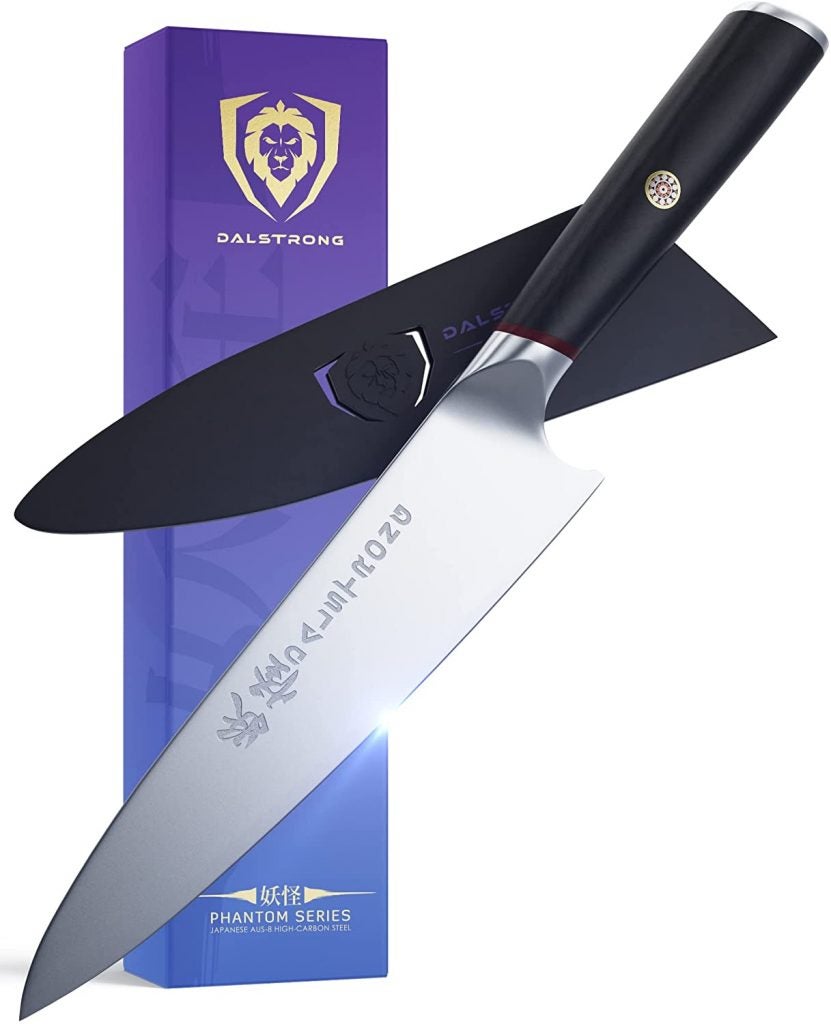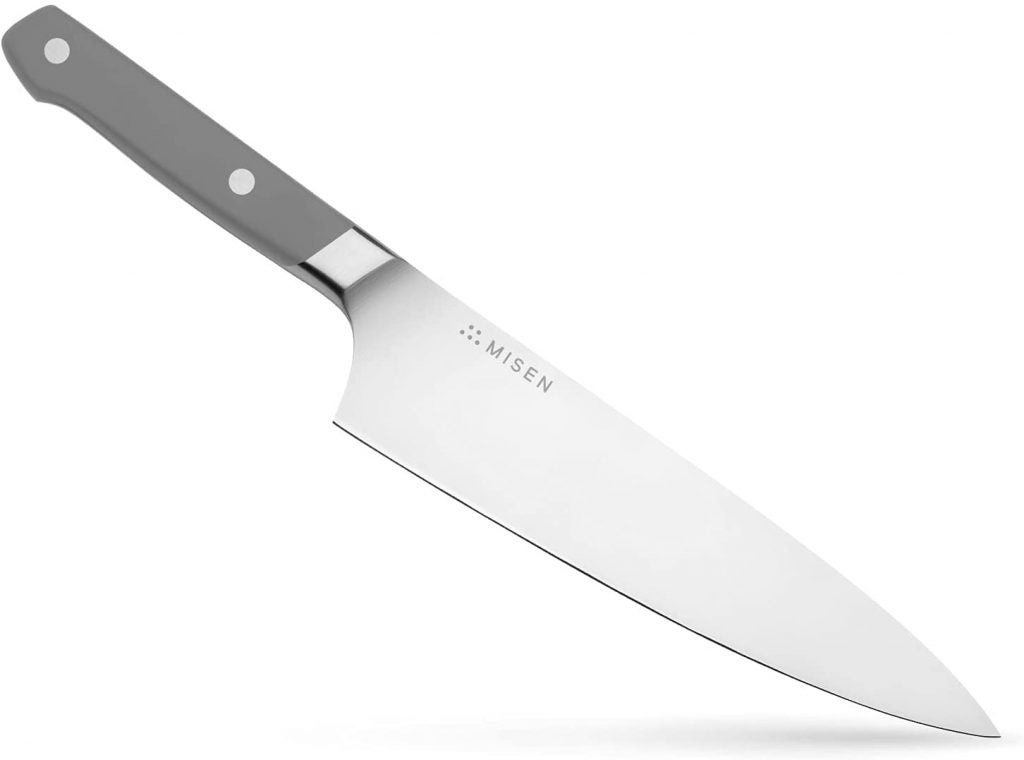Best Carbon Steel Knife
A carbon steel knife can be a great addition to the collection of kitchen knives that you use daily to prepare delicious homemade meals. But before you buy one, there are several pros and cons that you should consider.
First off, carbon steel knives aren’t always the most good looking knives because they aren’t resistant to discoloration and stains like other materials are. If you don’t keep them clean and completely dry, they might even develop rust. And if you use this type of blade to cut through acidic ingredients, you can expect that it will become discolored. So, these knives do require extra care, and you need to become accustomed to how to keep these knives in the best shape possible.
Despite some drawbacks, carbon steel knives are still really popular simply because they are so durable, sharp, and long-lasting. Compared to a stainless steel blade, you’ll likely find that a high carbon blade stays sharper and holds its edge longer. Plus, carbon steel knives can also be sharpened easily if they do start to become too dull, so that’s convenient. You can also take steps, such as using mineral oil or allowing a patina to form, to prevent rust from forming on the blade.
If you want the best of both worlds, you can search for high carbon stainless steel knives. These are durable, can maintain their sharpness over time, and come with the additional perk of being resistant to rust and staining.
Are you ready to check out some of the best carbon steel knives that are on the market? We’ve compiled a list of six products to help you get started, and you can read a bit about them below.
1. Editor’s Pick: Misono Swedish Carbon Steel Gyuto
First on our list of the best carbon steel knives is this one from Misono, which features high-quality Swedish carbon steel. We like that it is hand forged, and the dragon design on the blade adds a stylish touch. Also, the material of the handle on this knife is composite wood.
But design isn’t enough when it comes to a knife; it also needs to work effectively. Well, this knife is very sharp and features a 70:30 asymmetrical bevel. It is also versatile enough to be used for a range of purposes in the kitchen. You can use this knife to cut everything from meat to veggies, as it is thin and lightweight and it will maintain its sharpness over time.
One thing to keep in mind about this knife is that it is not stain resistant. Therefore, extra care needs to be taken to ensure it remains in good condition. For example, you shouldn’t wash this knife in the dishwasher, and it can become rusted or discolored if it remains wet after use, so be sure to dry it thoroughly right away.
Pros:
- This knife features Swedish carbon steel
- It is available in three sizes: 8.2” (this one doesn’t have the dragon design on the blade), 9.4”, and 10.5”, so you can choose one or add different sizes to your kitchen toolkit
Cons:
- This knife can be challenging to take care of, so it’s important to be aware of what steps need to be taken to keep it free of rust
- The dragon engraving is attractive, but might require some extra attention to be sure it doesn’t remain wet
2. Runner Up: MASAMOTO CT Gyuto Chef Knife
Another option is this multipurpose knife from MASAMOTO. It features a carbon steel blade that is 8” long, but it measures 13.7” x 2.2” x 1.1”. You can use this for cutting various meats, fish, and vegetables, so it can be your go-to tool for a variety of tasks, such as chopping, peeling, paring, and slicing. The curved blade also makes it easy to perform a rocking motion when chopping and preparing ingredients.
We like that this product is made by craftsmen in Japan. It features a double bevel cutting edge on the razor sharp blade, along with a bolster that helps keep water from getting into the wooden handle. Plus, it is easy to sharpen using a grindstone whenever necessary.
The handle on this knife is moderately weighted, and is designed to be easy to use when applying some force to ingredients. Just be sure to thoroughly clean and wipe this knife to keep it dry after you use it, as doing so can help prevent rust. And this knife should not be washed in the dishwasher either.
Pros:
- The curved, double-edged blade on this knife is crafted using the finest carbon steel
- The easy-to-grip handle is made of rosewood
Cons:
- The price is high, so it might be out of your budget if you don’t have a lot of money to spend on a carbon steel knife
- This knife should not be used on hard ingredients, such as frozen foods, as there’s a risk the blade will break
3. Best High Carbon: Kessaku Chef Knife – Samurai Series – Japanese Etched High Carbon Steel
If you would prefer a high carbon stainless steel knife that is easier to maintain than traditional carbon steel knives, check out this option from Kessaku. This handcrafted, professional level product can help you prepare a variety of meals right at home. And, in addition to being made from high-quality materials, this knife is designed in Japan and created with the help of cutting edge technology.
Thanks to the high carbon stainless steel that is used to make this knife, it is resistant to rust and corrosion. The blade is hard and strong, and this knife is designed to be well-balanced too. Therefore, it can be easy to use, reducing the odds of experiencing aches in your hands and fingers
The mirror polished handle features smooth pakkawood in a stylish design, and it is comfortable to hold in your hands, as well as strong for durability. Plus, the handle on this full tang knife is resistant to moisture and hot and cold temperatures. And, because it is seamless, it can prevent debris from getting inside.
Pros:
- The blade on this knife is precision forged and extremely sharp, so you can chop, dice, mince, and cut a variety of ingredients easily
- This product comes with a cleaning cloth, and it arrives in an attractive box that you can use to store your knife safely
- It comes with a 100% lifetime warranty
Cons:
- You still need to take care to keep this knife in tip-top shape, and it’s best to hand wash it before wiping and drying it thoroughly
4. Best Budget: Ontario Knife – Old Hickory 7-7 7″ Carbon Steel Butcher / Kitchen Knife
If you really want to buy yourself a carbon steel knife but you don’t have a lot of money to spend, we recommend checking out this carbon steel butcher/kitchen knife from the brand Ontario Knife. It features 1095 carbon steel and a wood handle, so it gives you just what you need in this type of knife, without some of the extras that other brands might promote.
This knife can be sharpened easily, so whenever it gets dull, you can sharpen it again to make it good as new. We also like that the hardwood handle, which is branded with the words “Old Hickory,” is securely attached to the blade with brass compression rivets.
Overall, if you are looking for a budget option, this might be right for you, but extra care needs to be taken to avoid rust on the blade. It is a carbon steel knife, after all.
Pros:
- This knife is super affordable for anyone who doesn’t have a lot of money to spend on a new carbon steel knife for their kitchen
- When properly cared for, this type of knife can last a long time
Cons:
- This knife requires the extra care that any other carbon steel knife would need, so be sure to hand wash it carefully and dry it completely right after you use it
5. German Carbon Steel Knife: Cutluxe Chef Knife – 8 Inch Kitchen Knife Forged of High Carbon German Steel
This chef knife from Cutluxe features high carbon stainless steel with a plain blade edge and a black, luxury pakkawood handle. It looks good, and it is designed to work well when you need to cut through a variety of ingredients.
This full tang knife features an ergonomic design and German steel. The blade is super sharp, it has been hand sharpened, and it has great edge retention. The handle is triple-riveted, laminated, and polished so it can be easy to keep clean. Plus, this knife is easy to grip, balanced, and stable in your hands. And it has a tapered bolster, so you can use it with confidence.
Overall, this can be a great choice if you’re looking for a premium quality knife that was precision forged from just one piece of high-quality steel. Plus, this is also a good option for those looking for a knife that is capable of heavier duty tasks, such as getting through thick meats and veggies.
Pros:
- This knife can help make precision slicing, mincing, dicing, and chopping easy
- It is resistant to stains, corrosion, rust, and wear, with excellent edge retention
- It comes with a lifetime warranty
Cons:
- If you want a true carbon steel knife, rather than one made from high carbon stainless steel, this one likely won’t be a good match
6. Best Low-Cost Option: Saken Chef Knife- High Carbon German Steel
Another low-cost option that we think is worth looking into is this chef knife from Saken. It is designed to be your ultimate kitchen knife, with a blade that makes cutting, mincing, slicing, and chopping super simple.
This high carbon German steel knife can help you save time when preparing meals, and it is made in a way that can help ensure it will last a long time. Plus, with this knife, you can cut slices that are paper-thin if that’s what you need.
Standout features include a black, satin finished handle that is seamlessly attached to the blade so you can enjoy a balanced grip. There is also a full bolster to help protect your fingers, along with a three pin design in the handle. The blade is hand sharpened and double beveled, with a sharp edge. It boasts great edge retention and is resistant to wear, so if you take care of this knife, it can stay sharp and continue working well.
Pros:
- This knife is made from German high carbon steel that can remain sharp for a long time
- The 8” blade and the pakkawood handle are durable and wear-resistant
- The blade is sturdy and can be used to cut a variety of ingredients
- It arrives in a gift box
Cons:
- Some customer reviews show disappointment with the quality of the handle of this knife
- The blade might be too large for some people to use comfortably and easily
7. Best Agile: Dalstrong Chef Knife
DALSTRONG’s 8-inch carbon steel chef knife is fantastically sharp out-of-the-box ready addition to your bladed arsenal. It features a full tang made of high-carbon AUS-8 steel with a minimum of a 58 Rockwell hardness. As a carbon steel knife you can expect fantastic edge sharpness and retention, but keep in mind that this isn’t a bone breaker. Here, agility is the name of the game. DALSTRONG also features some handsome engraving on the blade. One thing we really liked was the bevelled bolster for a pinch-grip backed up by the hooked end of the blade itself. This provides a lot of comfort, both psychological and otherwise, plus a healthy amount of fine control.
The DALSTRONG also impresses with a pakkawood laminated handle. Finally, the knife is backed by both a lifetime warranty, although only in regards to blade defects, and a 100% satisfaction or your money back guarantee.
Pros
- Full tang of high carbon AUS-8 steel.
- Minimum 58 Rockwell hardness.
- Pakkawood laminated handle.
- Lifetime warranty for defects and a 100% money-back guarantee if unsatisfied.
- Full bolster-grip.
- Included sheath, and gift box – perfect for holidays or birthdays.
Cons
- Some customer reports of knife breakage under professional-intensity usage.
8. Best Edge Retention: WUSTHOF IKON High Carbon Chef’s Knife
WUSTHOF’s IKON 8-inch chef’s knife is the latest in WUSTHOF’s search for a sharper, longer-lasting edge. As a carbon steel chef’s knife you can expect a Rockwell hardness of 58 and a standardized 15 degree blade angle. The steel itself is made from a single-block, which is then worked into the full-tang. Compared to other knives on this list the WUSTHOF is more of a workhorse, but it still requires some care when it comes to both bone and anything strongly acidic.
WUSTHOF also advertises that this blade is 20% sharper, and with better edge retention than previous models. In practice this is hard to measure as a consumer, but given the company’s 200+ year history there is a strong pedigree of excellence here. One of the best things about WUSTHOF’s carbon steel chef’s knife is that its out-of-the-box sharpness is out of this world. You can expect to get right to cooking after a simple paper-test. With all that said, there have been a few reports of resellers on Amazon so make sure that you buy directly from WUSTHOF. Likewise, our one build-quality complaint is that the handle is made of a polyoxymethylene composite. This is a great material in terms of durability, but we prefer laminated wood or something similar.
Pros
- Full, triple-riveted tang made from a single block of high carbon steel.
- 58-59 Rockwell hardness.
- Half-bolster grip, allowed for easy sharpening of the blade, but slightly less pinch-grip control.
- New Precision Edge Technology (PEtec) that increase sharpness and durability by 20% compared to previous models.
Cons
- Some customer reports of resellers – make sure you buy directly from WUSTHOF.
- Although somewhat of a personal preference the handle is an epoxy resin rather than sealed or laminated wood – considering the price point this is a bit of a disappointment.
9. Best Minimal: Misen Chef Knife
The Misen high carbon chef’s knife is a well-balanced minimalistic addition to your kitchen at half the cost of some of the knives on this list. Make no mistake, this isn’t in the upper echelons of carbon steel knives, but it’s hands-down one of the best cost-to-benefit knives on this list. Misen’s chef knife features a sturdy, triple-riveted tang forged from high carbon AUS-10 steel. Like the other knives on this list this means that you’ll need to be mindful of rust build up through water-contact. We like the dry towel wet towel approach to make this easier. The Misen also sports a fairly standard Rockwell hardness of 58 or 59.
Misen’s high carbon kitchen knife combines both western and Japanese knife design principles. The curve of the blade sits somewhere between a Japanese straight edge and the more rounded shape of a traditional German blade. It also features a nice bolster grip for improve overall knife agility.
Ultimately, Sous Vide Guy would call this a “prosumer” knife. It’s significantly better than anything you could find in a department story, cheaper than most high carbon knives, and compromises in remarkably few areas. This is a great knife for home cooks looking to step up their game with breaking the bank. As a nice bonus, the Misan was also crowd-funded so you can feel good about picking up a community-backed blade.
Pros
- Full, triple-riveted tang made from high carbon AUS-10 steel.
- 58-59 Rockwell hardness.
- Combines Japanese and Western knife designs – sitting between the Japanese straight and German rounded.
- Kickstarter-funded – this was a knife that people wanted, and put out money in advance for – always a good sign.
Cons
- Machine sharpened out-of-the-box – make sure to hone then sharpen to guarantee a good cutting edge and get rid of these burrs.
Things to look out for:
As you shop for a high-quality carbon steel knife, you can keep the following in mind to guide your decision:
When buying any knife, you want to take its size into consideration, so read through product details carefully to figure out how long a knife is from the tip of the blade to the end of the handle, and also check how big the blade itself is. You want to go with one that will be the right size for you, as some people find it difficult to handle larger knives or those that are too small.
Remember: if you don’t want to deal with the upkeep that comes with a traditional carbon steel knife, consider going with a high carbon stainless steel knife instead. You can also read through customer reviews of both of these types of knives to get an idea of how hard they are to maintain when it comes to avoiding things like stains and rust.
FAQs
What is a carbon steel knife used for?
Carbon steel is typically used in mid-high to high-end kitchen knives. This is because the addition of carbon during forging results in better wear-resistance and a longer-lasting edge. Carbon steel knives are also great when working with both honing steels and sharpening steels. The high quality of the blade steel responds well to both, meaning that whipping your knives back into shape is several shades easier than when working with lower quality steel. With all that said, keep in mind that most carbon steel knives are not designed for heavy, bone-breaking oriented blade work. Leave that to cleavers and other heavily weighted blades. Likewise, these are tools that need to be maintained and taken care of – primarily due to decreased corrosion resistance.
What should you not cut with carbon steel knives?
As mentioned above, you should avoid cutting anything that requires weight over sharpness to cut. This includes most butchery work, frozen food, dense produce like coconuts, or anything with a high-degree of acidity. By the latter we mean that you should avoid working with pineapple and jackfruit in particular, as both will fight your blade from top to bottom of the cut.
Is a carbon steel knife the same as a high carbon stainless steel knife?
The short answer to this question is no. Carbon steel knives and high carbon stainless steel knives differ in both performance and alloy content during the forging process. Carbon steel will have less than 10.5% alloy content, which is one of the reasons the blades are so sharp yet delicate. Stainless steel blades meanwhile contain a higher percentage of alloys in part to make the blade more robust and increase its ease of use. Typically, this comes in the form of at least 10% chromium, although other alloys can be used.
How do you sharpen a carbon steel knife?
Carbon steel stays sharper significantly longer than other knives, and is easier to sharpen to boot. The trick here is that you need to use a wet stone for sharpening in addition to oiling the blade. Use a wet stone even strokes across the surface, often from left to right. It’s important to make sure that you treat each part of the blade during this process, ideally at about a 15-degree angle. You’ll know that it’s working when you see the water becoming discolored where the blade makes contact with the wet stone.
During the first few months of usage, we also recommend using a drop or two of mineral oil to encourage the development of a patina. You can also prime the blade for this by rubbing it down with something lightly acidic right out of the box. Finally, make sure to oil you blade every few months if using daily, or every six months if under limited usage. This will help maintain the blade over time.
What oil should you use to maintain your carbon steel knife?
Sous Vide Guy strongly recommends using food-grade mineral oil on your carbon steel blades. Typical kitchen oils like canola or extra virgin can build up resin over time, which leads to sticky blades and less protection. This can be done after every use, although we prefer thoroughly drying the knife and saving the oil treatment for once every few months.
How do you stop carbon steel knives from rusting?
Taking care of a carbon steel knife starts on day 1. Ideally you want to begin by building a good baseline for a patina on the blade. A patina can be thought of as a protective layer of “good rust” that helps protect the blade from “bad rust” due to general usage. It’s also what gives carbon steel knives their unique patterning over time.
You can get this process off to a good start by using something mildly acidic, like ground coffee. With that said anything that is acidic, like a cut tomato, can be used here. Just make sure to wipe it down afterwards and follow the knife-care instructions above (AKA sharpening with a wet stone, using a few drops of mineral oil during the first 3 months or so, then regular oiling every quarter to half year).

